Ruijie Zhu
MeshSplat: Generalizable Sparse-View Surface Reconstruction via Gaussian Splatting
Aug 25, 2025Abstract:Surface reconstruction has been widely studied in computer vision and graphics. However, existing surface reconstruction works struggle to recover accurate scene geometry when the input views are extremely sparse. To address this issue, we propose MeshSplat, a generalizable sparse-view surface reconstruction framework via Gaussian Splatting. Our key idea is to leverage 2DGS as a bridge, which connects novel view synthesis to learned geometric priors and then transfers these priors to achieve surface reconstruction. Specifically, we incorporate a feed-forward network to predict per-view pixel-aligned 2DGS, which enables the network to synthesize novel view images and thus eliminates the need for direct 3D ground-truth supervision. To improve the accuracy of 2DGS position and orientation prediction, we propose a Weighted Chamfer Distance Loss to regularize the depth maps, especially in overlapping areas of input views, and also a normal prediction network to align the orientation of 2DGS with normal vectors predicted by a monocular normal estimator. Extensive experiments validate the effectiveness of our proposed improvement, demonstrating that our method achieves state-of-the-art performance in generalizable sparse-view mesh reconstruction tasks. Project Page: https://hanzhichang.github.io/meshsplat_web
Scaling Linear Attention with Sparse State Expansion
Jul 22, 2025Abstract:The Transformer architecture, despite its widespread success, struggles with long-context scenarios due to quadratic computation and linear memory growth. While various linear attention variants mitigate these efficiency constraints by compressing context into fixed-size states, they often degrade performance in tasks such as in-context retrieval and reasoning. To address this limitation and achieve more effective context compression, we propose two key innovations. First, we introduce a row-sparse update formulation for linear attention by conceptualizing state updating as information classification. This enables sparse state updates via softmax-based top-$k$ hard classification, thereby extending receptive fields and reducing inter-class interference. Second, we present Sparse State Expansion (SSE) within the sparse framework, which expands the contextual state into multiple partitions, effectively decoupling parameter size from state capacity while maintaining the sparse classification paradigm. Our design, supported by efficient parallelized implementations, yields effective classification and discriminative state representations. We extensively validate SSE in both pure linear and hybrid (SSE-H) architectures across language modeling, in-context retrieval, and mathematical reasoning benchmarks. SSE demonstrates strong retrieval performance and scales favorably with state size. Moreover, after reinforcement learning (RL) training, our 2B SSE-H model achieves state-of-the-art mathematical reasoning performance among small reasoning models, scoring 64.7 on AIME24 and 51.3 on AIME25, significantly outperforming similarly sized open-source Transformers. These results highlight SSE as a promising and efficient architecture for long-context modeling.
ZeCO: Zero Communication Overhead Sequence Parallelism for Linear Attention
Jul 02, 2025Abstract:Linear attention mechanisms deliver significant advantages for Large Language Models (LLMs) by providing linear computational complexity, enabling efficient processing of ultra-long sequences (e.g., 1M context). However, existing Sequence Parallelism (SP) methods, essential for distributing these workloads across devices, become the primary bottleneck due to substantial communication overhead. In this paper, we introduce ZeCO (Zero Communication Overhead) sequence parallelism for linear attention models, a new SP method designed to overcome these limitations and achieve end-to-end near-linear scalability for long sequence training. For example, training a model with a 1M sequence length across 64 devices using ZeCO takes roughly the same time as training with an 16k sequence on a single device. At the heart of ZeCO lies All-Scan, a new collective communication primitive. All-Scan provides each SP rank with precisely the initial operator state it requires while maintaining a minimal communication footprint, effectively eliminating communication overhead. Theoretically, we prove the optimaity of ZeCO, showing that it introduces only negligible time and space overhead. Empirically, we compare the communication costs of different sequence parallelism strategies and demonstrate that All-Scan achieves the fastest communication in SP scenarios. Specifically, on 256 GPUs with an 8M sequence length, ZeCO achieves a 60\% speedup compared to the current state-of-the-art (SOTA) SP method. We believe ZeCO establishes a clear path toward efficiently training next-generation LLMs on previously intractable sequence lengths.
DepthMaster: Taming Diffusion Models for Monocular Depth Estimation
Jan 05, 2025



Abstract:Monocular depth estimation within the diffusion-denoising paradigm demonstrates impressive generalization ability but suffers from low inference speed. Recent methods adopt a single-step deterministic paradigm to improve inference efficiency while maintaining comparable performance. However, they overlook the gap between generative and discriminative features, leading to suboptimal results. In this work, we propose DepthMaster, a single-step diffusion model designed to adapt generative features for the discriminative depth estimation task. First, to mitigate overfitting to texture details introduced by generative features, we propose a Feature Alignment module, which incorporates high-quality semantic features to enhance the denoising network's representation capability. Second, to address the lack of fine-grained details in the single-step deterministic framework, we propose a Fourier Enhancement module to adaptively balance low-frequency structure and high-frequency details. We adopt a two-stage training strategy to fully leverage the potential of the two modules. In the first stage, we focus on learning the global scene structure with the Feature Alignment module, while in the second stage, we exploit the Fourier Enhancement module to improve the visual quality. Through these efforts, our model achieves state-of-the-art performance in terms of generalization and detail preservation, outperforming other diffusion-based methods across various datasets. Our project page can be found at https://indu1ge.github.io/DepthMaster_page.
Reflections from the 2024 Large Language Model (LLM) Hackathon for Applications in Materials Science and Chemistry
Nov 20, 2024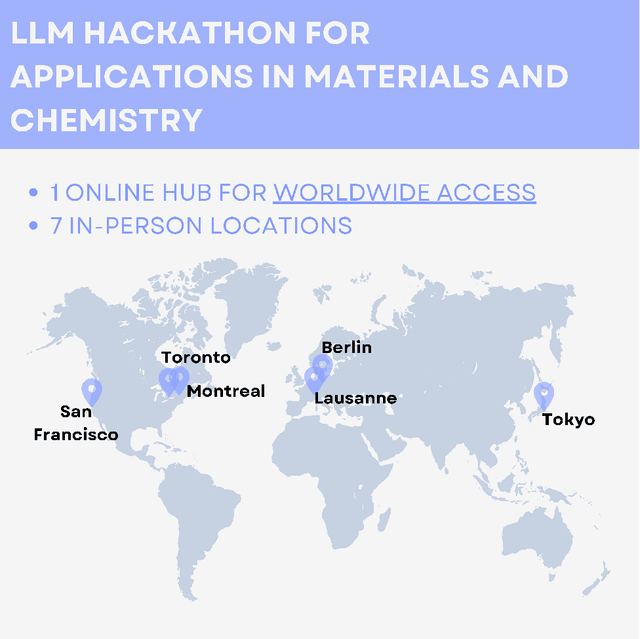
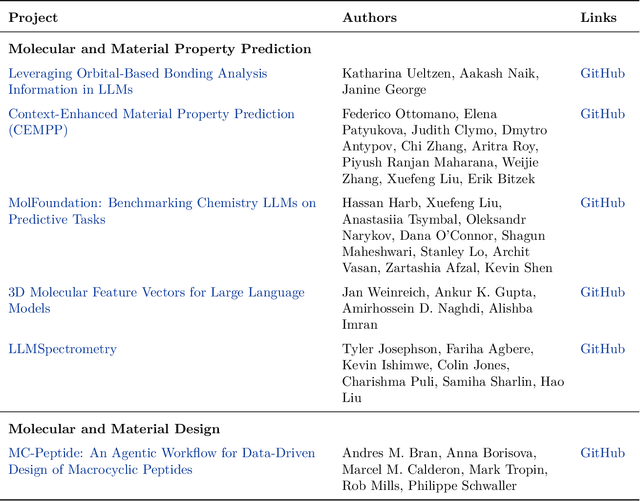
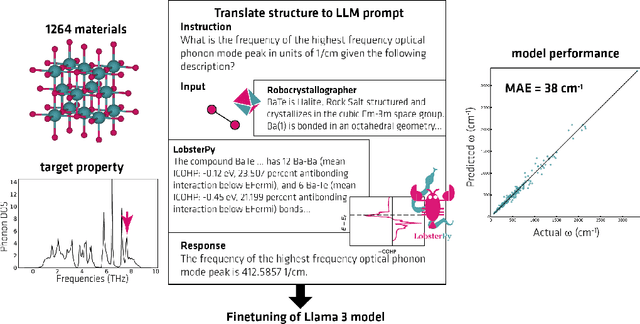

Abstract:Here, we present the outcomes from the second Large Language Model (LLM) Hackathon for Applications in Materials Science and Chemistry, which engaged participants across global hybrid locations, resulting in 34 team submissions. The submissions spanned seven key application areas and demonstrated the diverse utility of LLMs for applications in (1) molecular and material property prediction; (2) molecular and material design; (3) automation and novel interfaces; (4) scientific communication and education; (5) research data management and automation; (6) hypothesis generation and evaluation; and (7) knowledge extraction and reasoning from scientific literature. Each team submission is presented in a summary table with links to the code and as brief papers in the appendix. Beyond team results, we discuss the hackathon event and its hybrid format, which included physical hubs in Toronto, Montreal, San Francisco, Berlin, Lausanne, and Tokyo, alongside a global online hub to enable local and virtual collaboration. Overall, the event highlighted significant improvements in LLM capabilities since the previous year's hackathon, suggesting continued expansion of LLMs for applications in materials science and chemistry research. These outcomes demonstrate the dual utility of LLMs as both multipurpose models for diverse machine learning tasks and platforms for rapid prototyping custom applications in scientific research.
MetaLA: Unified Optimal Linear Approximation to Softmax Attention Map
Nov 16, 2024



Abstract:Various linear complexity models, such as Linear Transformer (LinFormer), State Space Model (SSM), and Linear RNN (LinRNN), have been proposed to replace the conventional softmax attention in Transformer structures. However, the optimal design of these linear models is still an open question. In this work, we attempt to answer this question by finding the best linear approximation to softmax attention from a theoretical perspective. We start by unifying existing linear complexity models as the linear attention form and then identify three conditions for the optimal linear attention design: 1) Dynamic memory ability; 2) Static approximation ability; 3) Least parameter approximation. We find that none of the current linear models meet all three conditions, resulting in suboptimal performance. Instead, we propose Meta Linear Attention (MetaLA) as a solution that satisfies these conditions. Our experiments on Multi-Query Associative Recall (MQAR) task, language modeling, image classification, and Long-Range Arena (LRA) benchmark demonstrate that MetaLA is more effective than the existing linear models.
DN-4DGS: Denoised Deformable Network with Temporal-Spatial Aggregation for Dynamic Scene Rendering
Oct 17, 2024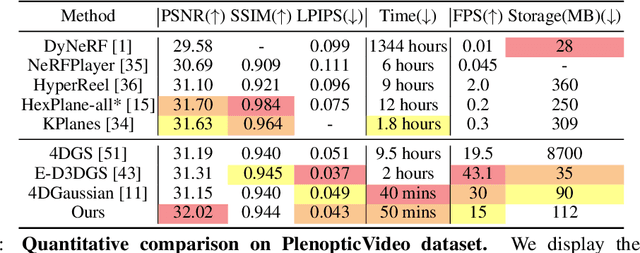
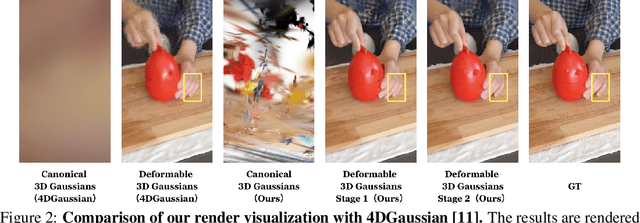
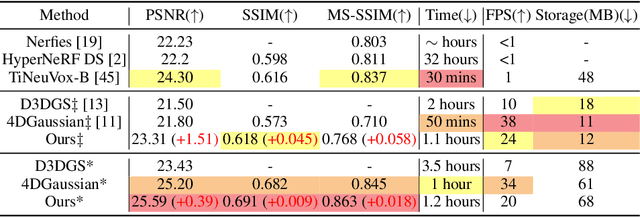

Abstract:Dynamic scenes rendering is an intriguing yet challenging problem. Although current methods based on NeRF have achieved satisfactory performance, they still can not reach real-time levels. Recently, 3D Gaussian Splatting (3DGS) has gar?nered researchers attention due to their outstanding rendering quality and real?time speed. Therefore, a new paradigm has been proposed: defining a canonical 3D gaussians and deforming it to individual frames in deformable fields. How?ever, since the coordinates of canonical 3D gaussians are filled with noise, which can transfer noise into the deformable fields, and there is currently no method that adequately considers the aggregation of 4D information. Therefore, we pro?pose Denoised Deformable Network with Temporal-Spatial Aggregation for Dy?namic Scene Rendering (DN-4DGS). Specifically, a Noise Suppression Strategy is introduced to change the distribution of the coordinates of the canonical 3D gaussians and suppress noise. Additionally, a Decoupled Temporal-Spatial Ag?gregation Module is designed to aggregate information from adjacent points and frames. Extensive experiments on various real-world datasets demonstrate that our method achieves state-of-the-art rendering quality under a real-time level.
MotionGS: Exploring Explicit Motion Guidance for Deformable 3D Gaussian Splatting
Oct 10, 2024



Abstract:Dynamic scene reconstruction is a long-term challenge in the field of 3D vision. Recently, the emergence of 3D Gaussian Splatting has provided new insights into this problem. Although subsequent efforts rapidly extend static 3D Gaussian to dynamic scenes, they often lack explicit constraints on object motion, leading to optimization difficulties and performance degradation. To address the above issues, we propose a novel deformable 3D Gaussian splatting framework called MotionGS, which explores explicit motion priors to guide the deformation of 3D Gaussians. Specifically, we first introduce an optical flow decoupling module that decouples optical flow into camera flow and motion flow, corresponding to camera movement and object motion respectively. Then the motion flow can effectively constrain the deformation of 3D Gaussians, thus simulating the motion of dynamic objects. Additionally, a camera pose refinement module is proposed to alternately optimize 3D Gaussians and camera poses, mitigating the impact of inaccurate camera poses. Extensive experiments in the monocular dynamic scenes validate that MotionGS surpasses state-of-the-art methods and exhibits significant superiority in both qualitative and quantitative results. Project page: https://ruijiezhu94.github.io/MotionGS_page
Gated Slot Attention for Efficient Linear-Time Sequence Modeling
Sep 11, 2024



Abstract:Linear attention Transformers and their gated variants, celebrated for enabling parallel training and efficient recurrent inference, still fall short in recall-intensive tasks compared to traditional Transformers and demand significant resources for training from scratch. This paper introduces Gated Slot Attention (GSA), which enhances Attention with Bounded-memory-Control (ABC) by incorporating a gating mechanism inspired by Gated Linear Attention (GLA). Essentially, GSA comprises a two-layer GLA linked via softmax, utilizing context-aware memory reading and adaptive forgetting to improve memory capacity while maintaining compact recurrent state size. This design greatly enhances both training and inference efficiency through GLA's hardware-efficient training algorithm and reduced state size. Additionally, retaining the softmax operation is particularly beneficial in "finetuning pretrained Transformers to RNNs" (T2R) settings, reducing the need for extensive training from scratch. Extensive experiments confirm GSA's superior performance in scenarios requiring in-context recall and in T2R settings.
Plane2Depth: Hierarchical Adaptive Plane Guidance for Monocular Depth Estimation
Sep 04, 2024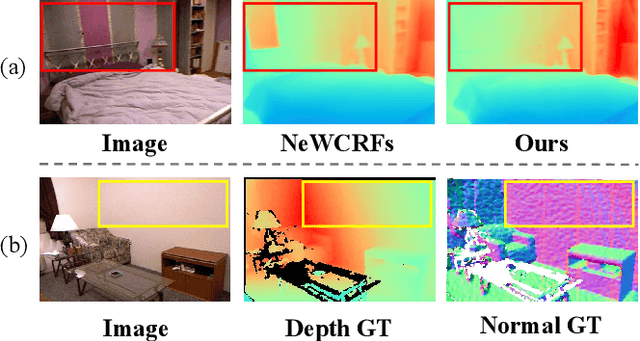
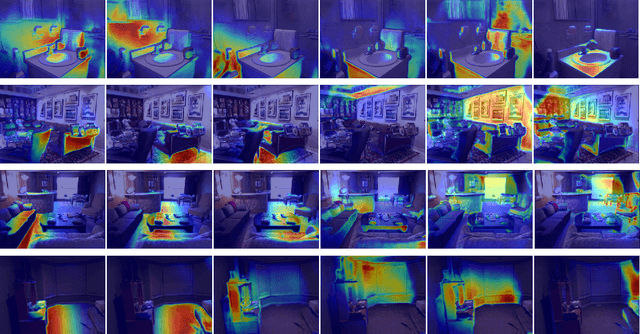
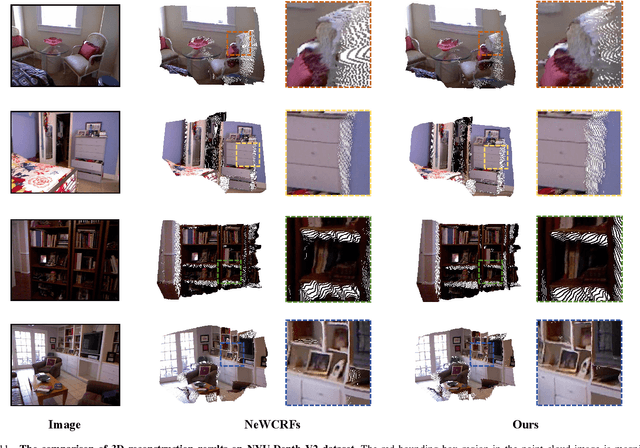
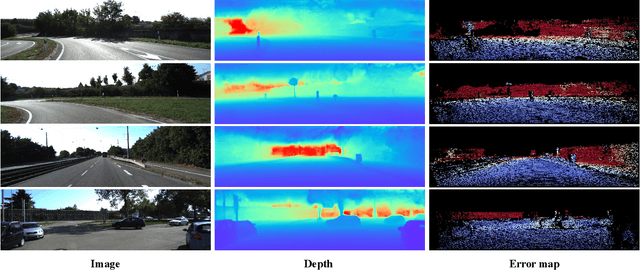
Abstract:Monocular depth estimation aims to infer a dense depth map from a single image, which is a fundamental and prevalent task in computer vision. Many previous works have shown impressive depth estimation results through carefully designed network structures, but they usually ignore the planar information and therefore perform poorly in low-texture areas of indoor scenes. In this paper, we propose Plane2Depth, which adaptively utilizes plane information to improve depth prediction within a hierarchical framework. Specifically, in the proposed plane guided depth generator (PGDG), we design a set of plane queries as prototypes to softly model planes in the scene and predict per-pixel plane coefficients. Then the predicted plane coefficients can be converted into metric depth values with the pinhole camera model. In the proposed adaptive plane query aggregation (APGA) module, we introduce a novel feature interaction approach to improve the aggregation of multi-scale plane features in a top-down manner. Extensive experiments show that our method can achieve outstanding performance, especially in low-texture or repetitive areas. Furthermore, under the same backbone network, our method outperforms the state-of-the-art methods on the NYU-Depth-v2 dataset, achieves competitive results with state-of-the-art methods KITTI dataset and can be generalized to unseen scenes effectively.
 Add to Chrome
Add to Chrome Add to Firefox
Add to Firefox Add to Edge
Add to Edge